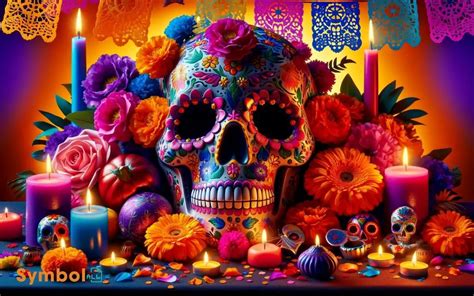The vibrant and intricate celebrations of the Day of the Dead, a traditional Mexican holiday honoring the deceased, are deeply rooted in a rich tapestry of symbolism. One of the most striking aspects of this festive and solemn occasion is the deliberate use of specific colors, each carrying its own unique meaning and significance. These colors are not merely decorative; they hold the power to convey complex emotions, beliefs, and values that are central to the observance of the Day of the Dead.
At the heart of the Day of the Dead celebrations are the altars, known as ofrendas, constructed to welcome the spirits of the deceased back into the world of the living. These altars are adorned with a plethora of items, including photographs, favorite foods, drinks, and, of course, a wide array of colorful decorations. The colors used in these decorations and throughout the celebrations are not chosen randomly; each has a specific role to play in the narrative of honoring and remembering those who have passed away.
The Significance of Colors
Orange and Yellow Marigolds: These flowers, locally known as zempasúchil, are arguably the most recognizable symbol of the Day of the Dead. They are believed to guide the spirits with their strong scent and vibrant colors, acting as a pathway from the cemetery to the family altars. The bright, warm hues of these flowers symbolize the sun and the light that guides the souls through the darkness, back to their families.
Purple: Representing grief, but also grandeur and royalty, purple is a complex and multifaceted color in the context of the Day of the Dead. It signifies the mourning and the sorrow associated with death but also celebrates the lives of the deceased, acknowledging their importance and stature within their families and communities.
Pink: This color is often associated with happiness and celebration, which might seem out of place in a mourning context. However, in the celebrations of the Day of the Dead, pink symbolizes the joy of reunification, the happiness of being together again with loved ones, and the celebration of life rather than the mourning of death.
White: Symbolizing purity and innocence, white is used to represent the spirits of children and the innocence of the soul. It is also a color that can signify hope and new beginnings, reflecting the belief that death is not an end but a transition to another form of existence.
Red: This bold color represents the blood of life, symbolizing the love and the bond that remains unbroken between the living and the dead. It can also signify the flame of life, passion, and the heart, emphasizing the continuity of love and connection despite physical separation.
The Cultural Context of Color
The use of these colors is not merely symbolic; it is deeply rooted in the cultural and historical context of Mexico and other countries that observe the Day of the Dead. The celebrations are a blend of indigenous traditions and Catholic beliefs, resulting in a unique amalgamation of practices and symbols. The colors, thus, serve as a bridge between the physical and spiritual worlds, facilitating the interaction between the living and the dead during this period.
Celebration and Remembrance
The Day of the Dead is a celebration of life, a time when families come together to honor their ancestors and loved ones who have passed away. The colors, along with other elements of the celebration, such as food, music, and dance, create a vibrant and welcoming atmosphere. This festive environment is not meant to belittle the significance of death but to underscore the importance of remembering and honoring those who have contributed to the fabric of family and community life.
Conclusion
The colors of the Day of the Dead are more than just decorative elements; they are carriers of deep symbolic meaning, reflecting the complexities of human emotion, belief, and the connection between the living and the dead. Through the deliberate and meaningful use of color, the Day of the Dead celebrations not only honor the deceased but also celebrate the cycle of life, emphasizing the continuity of love, memory, and legacy that transcends physical death.
What is the significance of orange and yellow marigolds in Day of the Dead celebrations?
+Orange and yellow marigolds, known locally as zempasúchil, are believed to guide the spirits of the deceased back to their families with their strong scent and vibrant colors. They symbolize the sun and the light that guides souls through the darkness.
How does the color purple represent both grief and grandeur in the context of the Day of the Dead?
+Purple signifies the mourning associated with death, acknowledging the sorrow and loss. However, it also celebrates the lives of the deceased, representing their importance and stature within their families and communities, thereby symbolizing grandeur and royalty.
What does the color white represent in Day of the Dead celebrations?
+White symbolizes purity and innocence, often used to represent the spirits of children. It also signifies hope and new beginnings, reflecting the belief that death is a transition to another form of existence rather than an end.



